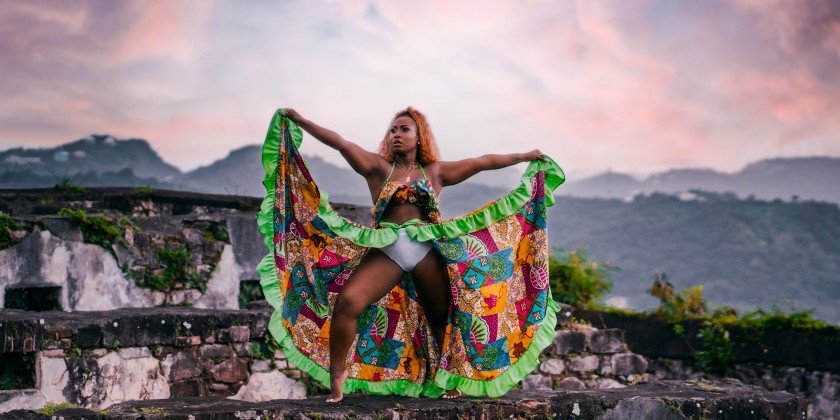Moving Caribbean in NYC: On Haitian Dance with Nadia Dieudonné and Julio Jean

Movement with a Reason
*NEWS OF HURRICAN MATTHEW 2016 AND DEVASTATION IN HAITI click link for USA Today article-The Dance Enthusiast will post info on "How You Can Help" when such information becomes available, for now see the American Red Cross Haitian Relief link below.
*Red Cross Haitian Relief
Afro-Haitian dance is a fusion of traditional African dances (primarily from the Kongo and Dahomeyan -or modern day Benin-regions) with elements of the Arawak Indian and French cultures. This blend came out of the Trans-Atlantic Slave Trade, during which many Africans were brought to the Caribbean island of Haiti as slaves, yet,despite the harsh conditions they endured, they were able to retain spiritual and cultural traditions .
There are secular dances within the tradition, such as social dances that arose from the popularity of contredanse music in the 19th and 20th centuries. There are also sacred dances typically performed in ceremonies in Vodou, the African spiritual tradition commonly practiced in the island of Haiti. The word Vodou means “Spirit”, and within the spiritual tradition, the dances represent the characteristics of the lwa, or spirits. Rhythms created with drums, songs, and dances work together to manifest the lwa in ceremonies through possession of their servants.

Scholarly sources document Afro-Haitian dance dating back to the 18th century, but the form became popular in the 20th century thanks to dancer, choreographer, and anthropologist Katherine Dunham. Dunham traveled to Haiti in the 1930s to study the cultural traditions of the island, and later presented Haitian traditional and ceremonial dances internationally through The Katherine Dunham Company. Elements of Afro-Haitian dance also heavily influenced Dunham in the creation of the Dunham technique.
I recently sat with choreographers and master teachers Nadia Dieudonné and Julio Jean to learn more about this form.
Nadia is a first-generation Haitian-American from Brooklyn, New York, who began studying Afro-Haitian dance at age 12 with the Haitian folk singer and community activist Myriam Dorisme. She later trained and performed with La Troupe Makandal, was mentored by Haitian dance icon Jean Leon-Destine, and then further studied the dance in the countryside of Haiti and the capital of Port-au-Prince. Nadia Dieudonné & Feet of Rhythm, a Haitian Folkloric Dance Company was founded in 1994, followed by Feet of Rhythm Kids Cultural Program & Dance Company in 1995.

Julio Jean began studying Afro-Haitian dance along with other Western dance forms at the National School of Arts in Haiti, before moving to the United States in 1989. Some of his teachers included former Katherine Dunham Company member, Lavinia Williams, as well as master teachers Herve Maxi and Fritz Jolicoeur. Jean has worked throughout the United States, and currently teaches Afro-Haitian Dance at Cumbe in Brooklyn. His Julio Jean Haitian American Dance Theater was founded in 1999.

Both Dieudonné and Jean acknowledge that there are elements of Afro-Haitian dance that can be found in other styles of dances of the African Diaspora. “The grounded movements, the earthiness, the African presence in all of the dances,” says Dieudonné. “The body isolations, some of the similarities in the music and the rhythms -- and even in the reasons why we do our dances. As in any African-based dance, it’s not just movement to do movement, but movement with a purpose.”
But what sets Afro-Haitian dance apart from other styles of Afro-Caribbean dance?
“The differences are mostly in tempo, accent and initiation” says Jean. For example, in Afro-Cuban dance they have a tendency to put the shoulders forward, whereas with us, we move them backwards.”
Afro-Haitian dance has also an influenced other dance forms throughout the Caribbean. “In Trinidad and Jamaica, even Dominica, there are many Haitians. So there are similarities where the Haitians integrated dance forms in those islands. Haitian dance is also a part of the Cuban heritage. The dances, the languages, the songs -- they even sing in Haitian-Creole! Creole is a second language in Cuba.”

The bond between the movement, songs and rhythms works together to strengthen the connection between deities, nature, and individuals. Those connections can happen for anyone who decides to participate in the art form, regardless of their spiritual beliefs. “Depending on the intent of the choreography, Afro-Haitian dance can bring with it a sense of community,” says Dieudonné . “There are dances that have a political context, in which the community comes forth to bring to light a situation or topic in regards to Haiti. Communities also come together to use song and dance to praise ancestors. Many of the traditional forms have songs with lyrics that allude to healing and protection. The dances can bring peace and a sense of release.”
“Afro Haitian dance can be used as a healing tool if you do it the way it’s designed. In a group, with chanting, it becomes powerful,” says Jean. “It changes the breath. The amount of breath can change the pattern of your brain, the vibrations. The dance can give you a sense of empowerment.”

For the past ten years, Dieudonné has run an annual summer program with Feet of Rhythm Kids called “Konbit”. The program culminates with her young students performing in the annual Children’s West Indian Day Parade that occurs on the Saturday before Labor Day. “Dance has given me everything that I’ve gotten in life. And no matter how much I try to say I’m going to move away from it, I always found myself right back in dance. Why not expose children to that? I’ve traveled throughout the world with dance, I just want to be able to give back, and expose children to the beauty of Haitian culture through the arts.”

The Dance Enthusiast Explores Dance and Creates Conversations
Join Dance Enthusiasts at our Enthusiastic Event! Dance:Island to Island-Moving Caribbean in NYC- November 16th at Gibney Dance 280 Broadway
Keep Your Eyes on our Website for More Information, Guest Panelists, and Performers











